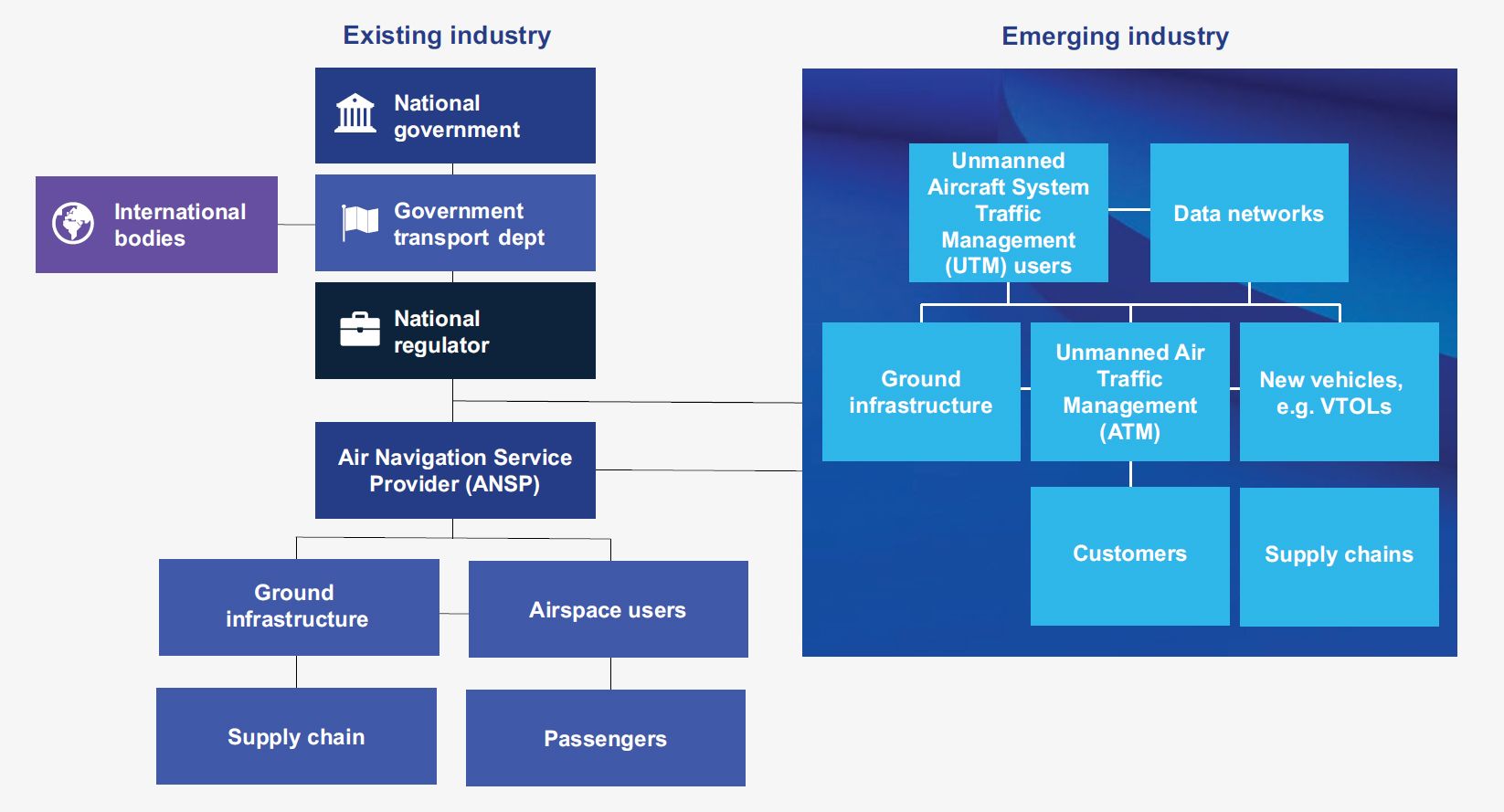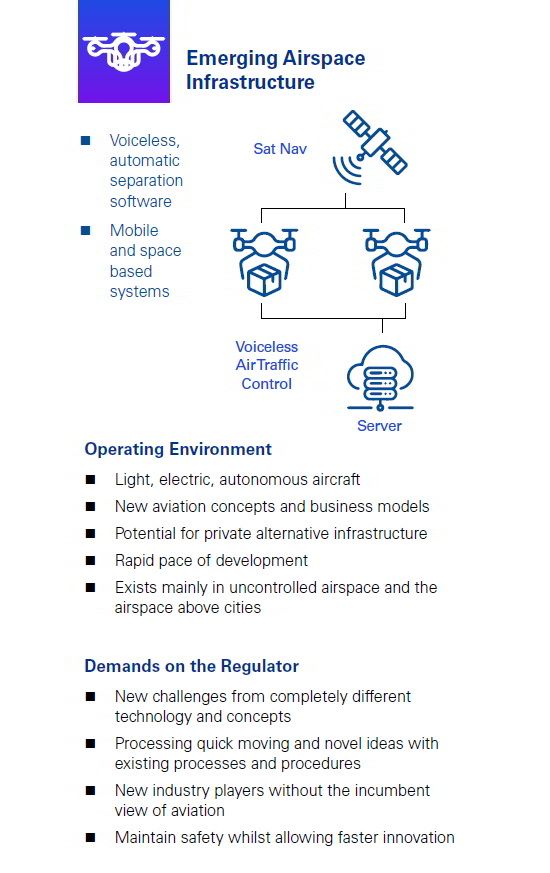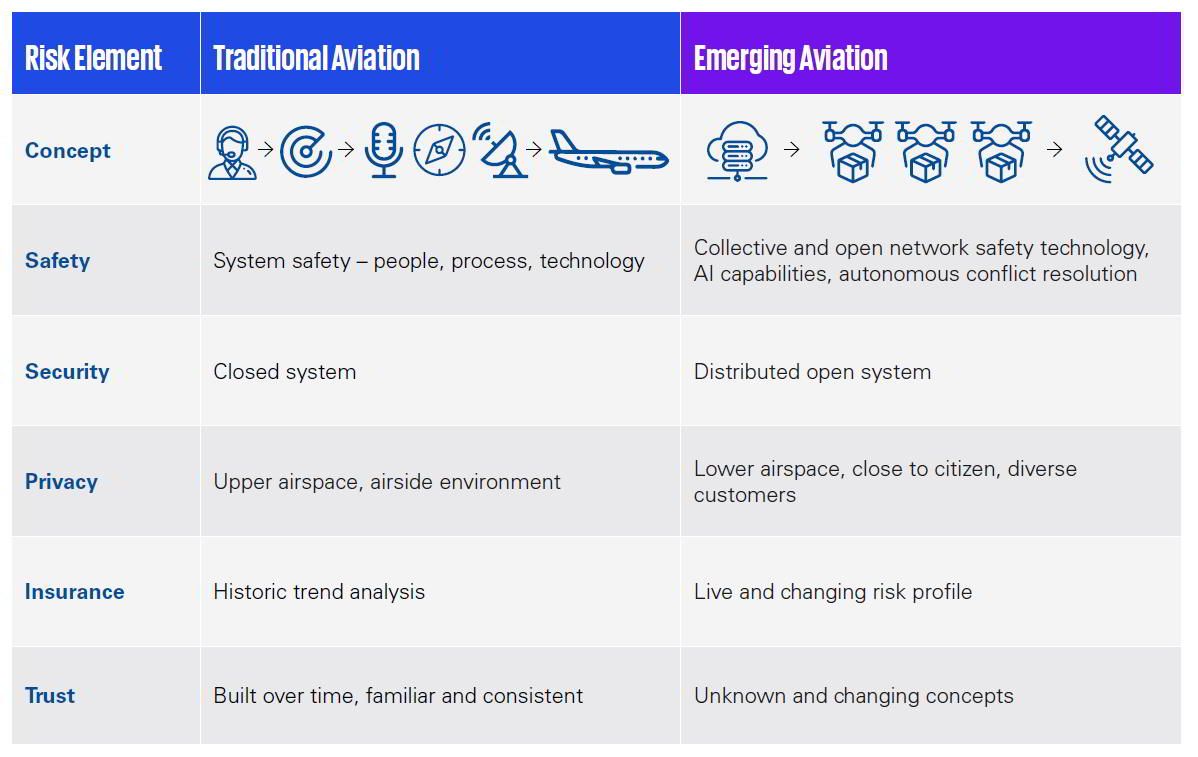As a new chapter in aviation begins, with air taxis and drone deliveries emerging, next generation air traffic control will require powerful new software, writes Chris Brown, Joe Taylor and Amit Dhebri.
Many litres of ink have been spilled discussing the nascent revolution in aviation. Barely a day goes by without fresh news of air taxis, unmanned vehicles, or new propulsion systems, and our own Aviation 2030 series has delineated in detail the implications of technology and consumer-led disruption in the sector.
So far though, the hype has focused overwhelmingly on aviation hardware: vehicles, propulsion systems and vertiports. But to function effectively and safely, next-generation aviation will need powerful new software as well: the ecosystem of regulatory protocols and standards that keep the machine running.
Whilst this infrastructure will be invisible to the eye and naturally less media-friendly than, say, concept eVTOLs (electric vertical take-off and landing vehicles), its development is no less critical to the next generation of aviation than was the foundational work of laying tracks to the triumph of the first trains. Our new ‘Highways and Skyways’ paper explores what exactly is needed and the challenges in getting there.
A mature aviation ecosystem for manned vehicles
Today’s aviation regulation is highly mature, having evolved over the best part of a century. It is built around highly familiar closed routes between airport security checkpoints, managed primarily by human operators and ground-based systems, to facilitate primarily fixed-wing aircraft flying long distances.
Regulation is formally managed by a range of national bodies, standards are agreed and well understood at the international level, and the Air Traffic Management infrastructure is owned and operated by central national monopolies. This is a human-centred industry, with pilots and controllers communicating by voice.
The old and the new
Merging Advanced Air Mobility and traditional aviation
As the ecosystem evolves, decisions need to be made about how the emerging industry is integrated, segregated, or interfaced with the existing aviation ecosystem, and what roles and responsibilities the different actors need to adopt.

The new aviation reality
The current model of airspace management has been successful in controlling the existing air traffic comprising of manned fixed wing aircrafts and helicopters. However, with proliferation of aerial vehicles in the sky and with the introduction of a new generation of unmanned vehicles, it is unlikely that the existing model would suffice.
Emerging airspace infrastructure will need to accommodate a host of new aircraft and journey types, as well as consumer segments, all of which are being developed at breakneck speed by a vibrant and so far generously-funded private sector. Vehicle numbers are set to explode as light, electric aircraft compete with current inter and intra city mobility options, making totally new demands on regulators and necessitating a new reliance on voiceless, computer-based systems.


Building the new aviation
The challenges posed by new aviation concepts such as drone delivery and air taxis are highly complex and distinct from those of traditional aviation, implying a greater range of customer types, as well as a far greater volume of aerial traffic in urban environments, flying much more closely to the built environment. Most of the new vehicles will necessarily occupy lower tiers of airspace and land in a wider variety of sites, whilst traffic regulation systems will be cloud and software-based, with distributed ownership, making cybersecurity far more complex.
The management of risk in aviation is therefore migrating from system-based security based on a known and bound system, to collective and distributed security based on multiple dynamic operational concepts and environments. This cannot happen overnight. Today’s regulatory environment has been built around traditional aviation, meaning that its rules and procedures often impinge upon the development of new business models.
National air traffic control services often have jurisdiction over the entire upper airspace of a country from border to border, confining experimental concepts to ‘uncontrolled’ airspace, in small volumes and close to the ground.
Often, even this low-lying airspace has restrictions that hamper innovation. In London, for instance, helicopters are subject to an Air Traffic Control (ATC) clearance and are required to fly along designated routes – restrictions that would make the development of, say, an air taxi service, difficult.
To address the limitations of existing airspace infrastructure, the industry needs to move towards either making the entire airspace controlled or to encourage the use of navigation instruments for each vehicle. These changes would facilitate the transition to beyond visual line of sight (BVLOS) operations.
New risks
Emerging aviation concepts have a completely different risk profile than the incumbent industry, from system-based risk based in a familiar setting, to collective and distributed involving new concepts, closer to the public.

The choices ahead for regulators
Regulators in all jurisdictions find themselves under significant pressure to respond to the challenges of next generation aviation, and accordingly we see a wide range of activity around the world. Globally, there are vastly different levels of ambition when it comes to new aviation adoption.
The options that regulators have to deal with now are fundamental questions that will shape the viability of the industry. Those finding the optimum mix will be leaders in the industry, being able to export infrastructure abroad (analogous to the standard railway sizes / construction). Our paper outlines six key questions that regulators will have to consider.
Moving to autonomous ATMS?
Moving from a human centred ATM system to a completely autonomous ATM system is a long leap, taking multiple years, perhaps decades, for this transition to complete. We therefore advocate for a crawl-walk-run approach, meaning small incremental steps are needed to move from the existing ATM an autonomous ATM. These incremental steps would facilitate a harmonious change, ensuring existing pilots absorb these changes as and when they occur, and the current infrastructure is progressively upgraded to support this shift.
Shadi Razak, Chief Technology Officer at ANGOKA, an IoT security company focused on protecting machine-to-machine communications for smart cities and mobility, says that AAM offers an opportunity for the efficiency and effectiveness of safety critical operations amongst other services, while reducing the overall operation cost. He notes however that regulatory and cybersecurity framework as well as the standard for air mobility urgently need to be updated to unlock the full potential and benefits of AAM.
“The diversity of AAM introduces the industry to a new, complex web of cyber threats and risks, which can endanger the safety of drone operations. Traditionally, approaches to secure cyber physical systems such as AAM systems are not fit for purpose, with the potential for operations and systems to be hindered or jeopardized if connectivity with an external or untrusted network is required to enable device protection.” notes Razak.
“Digital safety standards and regulations need to adopt a fresh view for AAM, progressing from traditional security and aviation standards. There is an essential need for the new security and regulatory frameworks to adapt futuristic principles such as zero trust and distributed security management through enhanced security by design and privacy by default throughout AAM operations and systems like drone, UTM, USS, crowd control stations and communication links.”
What should industry do to get there?
Building the governance and control frameworks for the aerial mobility of this century will be a collaborative enterprise, requiring the input of multiple stakeholders, each with overlapping interests:
Stakeholders from government, regulators and local authorities to customers, investors and have differing drivers and concerns. The future of aviation promises to be radically different from its recent past, and the regulatory software that will control it must be incubated today, on the same frenetic timeline as the much-hyped hardware of vertiports, drivetrains and vehicles. This will require unprecedented collaboration between the industry’s many competing interests, as well as rapid evolution at the organizational and conceptual levels. There are also major decisions to be made about the shape and structure of the emerging aviation ecosystem, and the level of public / private involvement in achieving it.
Our report looks at these concerns and makes a number of observations for these groups.
Get in touch
The pace of change is challenging leaders like never before. To find out more about how KPMG perspectives and fresh thinking can help you focus on what’s next for your business or organisation, please get in touch with Chris Brown, Head of Strategy. We’d be delighted to hear from you.
Christopher Brown
Partner, Head of Strategy
KPMG in Ireland


